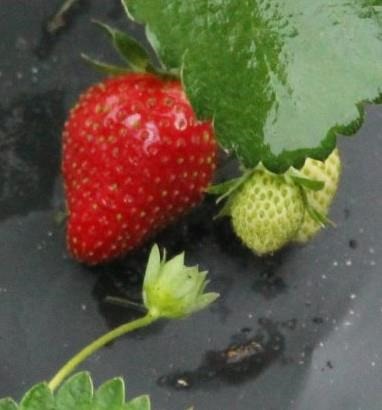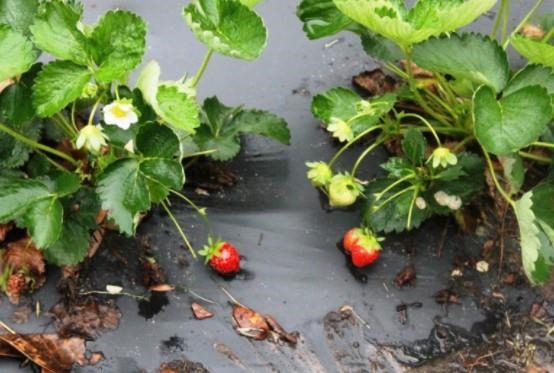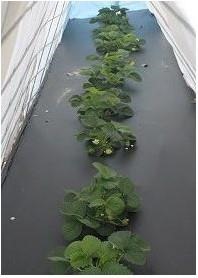By Matthew Orwat
As the alternating cycles of sun, heat and rain shape our summer days, I start thinking about cooler times ahead and the fall planting season. One plant to consider for cool-season producton are strawberries. Planting strawberries in the fall is really an exercise in preparation for bountiful production of fruit beginning in January and continuing through May. The following procedure will lead to a successful strawberry production if followed:

Strawberry plant producing fruit in late winter.
The best locations for strawberry production have well-drained, moist, sandy soil with substantial organic matter. It must not be too wet. The pH should be between 5.5 and 6.5, which is considered slightly acidic. A fertilizer scheme of 2 lbs. of a 10-5-10 fertilizer per 10 feet of row should be applied pre-plant, with ¼ of the fertilizer over the top and the rest in a one-inch-deep band near the location of drip irrigation. DO NOT apply fertilizer directly below the plants, as the fertilizer may burn the young transplants.
Beds with hills 6-8 inches high and 24 inches wide are commonly used. Drip irrigation should be installed for best results, thus keeping the leaves free of irrigation water. This hill should be covered with weed barrier, such as grower’s polyurethane plastic to reduce weed growth and soil splashing onto leaves.

Plastic barriers prevent splashing of soil borne disease spores onto leaves, and block weeds.
Short day cultivars that have been proven to do well in Northwest Florida production are Sweet Charlie and Camarosa. Transplants should be certified disease free from a reputable nursery. Sweet Sensation® Florida127, Florida Radiance and Florida Beauty are also recommended in the latest edition of the Vegetable Production handbook of Florida, but I have not had experience with them.

Strawberries under a homemade “low tunnel” system to prevent frost from damaging fruit.
While plants can easily withstand our winter temperatures, fruit can suffer damage from frosts below 32 degrees Fahrenheit. The good news is that small row covers or “low tunnels” can be constructed to prevent fruit loss and encourage early fruiting.
When setting out the transplants:
- Keep plants moist before planting
- Spread roots out in fan-shape
- Set plants in moist soil at the correct depth. Do not cover the plants crown with dirt or leave its roots exposed above the soil.
- Space plants 12 to 18 inches apart.
- Pack the soil firmly around the roots, then sprinkle with water. Overhead sprinkling may keep the tops from drying out until the roots can get established.
As stated above, strawberries should be mulched. Black polyethylene plastic mulch at 1 to 1½ mil thick is best (completely cover the top and sides of bed before planting). Be sure the bed is firm, formed correctly, moist, and fertilized adequately. Place soil on the edges of the plastic to hold it in place. Cut slits in the plastic for the transplants.
When using alternatives like straw, bark or other natural organic materials, mulch to a depth of 1 to 2 inches, but do not completely cover the plant.
Source : ufl.edu